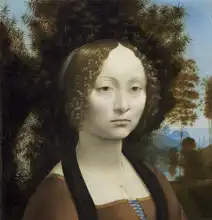About this finishing
Print. The image is printed on the top quality 10-ink HP Z9PS printer on HP matte 270 g / m2 paper. You can choose any size to an accuracy of 1 cm. A margin of 5 cm around the image is added to the size of the motif.


You can find a detailed description about our finishings
here.
Ginevra de Benci
Date:
15th centuryMedium:
oil on boardLocation:
National Gallery of Art, Washington DC, USA"Ginevra de' Benci" is a painting by the Italian
Renaissance artist
Leonardo da Vinci , completed around 1478-1480. The painting depicts a young Florentine noblewoman named Ginevra de' Benci, who was a member of a prominent Florentine family. Ginevra de' Benci is depicted in the foreground of the painting. Her figure is captured in half-body and stands in a landscape. Behind Ginevra is a landscape feature that includes a green forest and a dark sky. This contrast-rich background emphasizes the portrait in the center.
Ginevra holds a wreath of roses and myrtle in her hand, which can symbolize love and fidelity. There are also relief elements with inscriptions around it. Leonardo da Vinci used perspective and the technique of sfumato (hazy contours) to create a delicate and realistic image. Ginevra's eyes are expressive and the gaze into the countryside seems mysterious. The painting of Ginevra de' Benci is considered one of Leonardo da Vinci's early works and shows his artistic talent and innovative approach to portraiture.
Vinci painted picture Ginevra de Benci in 15th century. Prevailing color of this fine art print is dark and its shape is portrait. This art piece is located in National Gallery of Art, Washington DC, USA. This image is printed on demand - you can choose material, size and finishing.
Leonardo da Vinci (1452-1519). He was an important Italian
Renaissance painter, sculptor, architect, musician, mathematician and inventor. He is even considered the greatest humanist of all time. His works are special and innovative thanks to the search of compositional balance, the movement of characters and perspectives achieved by the play of light and colour. He used a distinctive colour blending technique known as sfumato. His attempt to capture the character, mood and expression of people was also significant. Among his most famous works are
The Last Supper, Lady with an Ermine, Self Portrait and of course
Mona Lisa, which is one of the most famous works of art in the history of painting.


